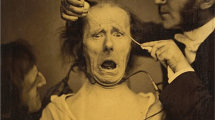Abstract
Electromyographic feedback in the treatment of facial paralysis has been shown to be a useful alternative to surgical procedures. In this paper we report on the partial recovery of a 7-year-old patient with congenital bilateral facial paralysis (Moebius syndrome) that had been considered untreatable by medical specialists. Biofeedback of electromyographic activity was provided together with specific instructions, social reinforcement, and exercises that the patient carried out at home. The rehabilitation training lasted 1 year, during which there was a substantial increase in the electromyographic activity of the muscles on both sides of the face. A follow-up after 1 year of discontinuing the treatment showed that the muscle activity had been maintained and that there was a marked improvement in the patient's mood and facial expression.
Similar content being viewed by others
References
Alcaraz, V. M., Castro Velazquez, I., de la Cruz, S., and del Valle, G. (1980). Condicionamiento y recuperación de funciones perdidas por daño cerebral. In Colotla, V. A., Alcaraz, V. M., and Schuster, C. R. (eds.),Modificación de Conducta. Aplicaciones del Análisis Conductual a la Investigación Biomédica, Editorial Trillas, Mexico City.
Balliet, R., Shinn, J. B., and Bach-y-Rita, P. (1982). Facial paralysis rehabilitation: Retraining selective muscle control.Int. Rehab. Med. 4: 67–74.
Booker, H. E., Rubow, R. T., and Coleman, P. J. (1969). Simplified feedback in neuromuscular retraining: An automated approach using electromyographic signals.Arch. Phys. Med. Rehab. 50: 621–625.
Carrobles, J. A., and Godoy, J. F. (1987).Biofeedback. Principios y Aplicaciones, Martínez Roca, Barcelona.
Cleeland, C. S. (1973). Behavioral techniques in the modification of spasmodic torticollis.Neurology 23: 1241–1247.
Colotla, V. A., Alcaraz, V. M., and Schuster, C. R. (eds.) (1980).Modificación de Conducta. Aplicaciones del Análisis Conductual a la Investigation Biomédica, Editorial Trillas, Mexico City.
Corral-Romero, M. A., and Bustamante-Balcárcel, A. (1982). Biofeedback rehabilitation in seventh nerve paralysis.Ann. Otol. Rhinol. Laryngol. 91, 2(pt. 1): 166–168.
Fernando, C. K., and Basmajian, J. V. (1978). Biofeedback in physical medicine and rehabilitation.Biofeed. Self-Regulat. 3: 435–455.
Frola, A., Gallegos, X., Rodriguez, D., and Bustamante, A. (1990). Rehabilitación de un caso de sinkinesis con retroalimentación electromiográfica.Rev. Mex. Psic. 7: 71–73.
Godoy, J. F. and Carrobles, J. A. I. (1986). Biofeedback and facial paralysis: An experimental elaboration of a rehabilitation program.Clin. Biofeed. Health 9: 124–138.
Jankel, W. R. (1978). Bell palsy: Muscle reeducation by electromyograph feedback.Arch. Phys. Med. Rehab. 59: 240–242.
Marinacci, A. A., & Horande, M. (1960). Electromyogram in neuromuscular re-education.Bull. L.A. Neurol. Soc. 25: 57–71.
May, M. (1986). Facial nerve disorders in the newborn and children. In May, M. (ed.),The Facial Nerve, Thieme, New York.
Olton, D. S., and Noonberg, A. R. (1980).Biofeedback. Clinical Applications in Behavioral Medicine, Prentice-Hall, Englewood Cliffs, NJ
Rubow, R. T., Rosenbek, J. C., Collins, M. J., and Cele, G. G. (1989). Reduction of hemifacial spasm and dysarthria following EMG feedback.J. Speech Hear. Disord. 49: 26–33.
Author information
Authors and Affiliations
Additional information
This research was partially supported by the Programa de Apoyo a las Divisiones de Estudios de Posgrado (PADEP) of the Coordinación General de Estudios de Posgrado of the Universidad Nacional Autónoma de México and by Sabbatical Fellowship 48367 granted by the Consejo Nacional de Ciencia y Tecnologia to the first author, who is presently on leave of absence at Coquitlam College, Coquitlam, B.C., Canada.
Rights and permissions
About this article
Cite this article
Gallegos, X., Medina, R., Espinoza, E. et al. Electromyographic feedback in the treatment of bilateral facial paralysis: A case study. J Behav Med 15, 533–539 (1992). https://doi.org/10.1007/BF00844946
Accepted:
Issue Date:
DOI: https://doi.org/10.1007/BF00844946




